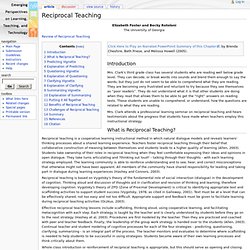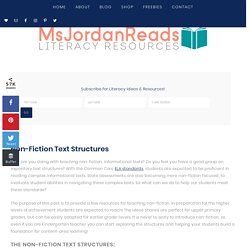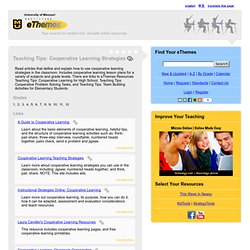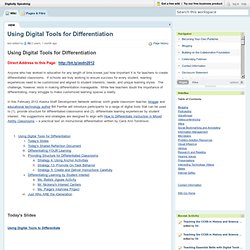

5 Alternatives To Bloom's Taxonomy For Teachers - This post is updated from an article we published in April.

40 Alternative Assessments for Learning. 4 Wonderful Critical Thinking Graphics. Differentiation. Differentiation - tools, tips and resources. Differentiation is an important aspect of education.

Students learn differently, have different needs, different backgrounds, different skills, different ability levels, different interests and more. As educators, we try to create engaging lesson activities that provide a variety of learning experiences and allow students to demonstrate their learning in different ways. Introduction to Cooperative Learning. An Overview Of Cooperative Learning David W Johnson and Roger T Johnson Without the cooperation of its members society cannot survive, and the society of man has survived because the cooperativeness of its members made survival possible….

It was not an advantageous individual here and there who did so, but the group. Summarization 6 Reciprocal Teaching Pt 1. Reciprocal Teaching: A Reading Comprehension Package. The intervention package teaches students to use reading comprehension strategies independently, including text prediction, summarization,question generation, and clarification of unknown or unclear content.

For effective-teaching tips to use when introducing this strategy, consult the guidelines presented introducing Academic Strategies to Students: A Direct-Instruction Approach. Materials: Overhead transparencies of practice reading passages, transparency markers Student copies of Be a Careful Reader! Reciprocal Teaching. From Emerging Perspectives on Learning, Teaching and Technology Elizabeth Foster and Becky Rotoloni The University of Georgia Review of Reciprocal Teaching Introduction Mrs.

Clark’s third grade class has several students who are reading well below grade level. Non-Fiction Text Structures! « Reading. Writing. Thinking. Sharing. How are you doing with teaching non-fiction, informational texts?

Do you feel you have a good grasp on expository text structures? With the Common Core ELA standards, students are expected to be proficient in reading complex informational texts. State assessments are also becoming more non-fiction focused, to evaluate student abilities in navigating these complex texts. So what can we do to help our students meet these standards? The purpose of this post is to provide a few resources for teaching non-fiction, in preparation for the higher levels of achievement students are expected to reach! The Non-Fiction Text Structures: Cooperative Learning Strategies. Global rating average: 0.0 out of 50.00.00.00.00.0 Read articles that define and explain how to use cooperative learning strategies in the classroom.

Includes cooperative learning lesson plans for a variety of subjects and grade levels. There are links to eThemes Resources Teaching Tips: Cooperative Learning for High School, Teaching Tips: Cooperative Problem Solving Tasks, and Teaching Tips: Team Building Activities for Elementary Students. Grades Links. 186 Videos that will make you go Huh, Whoa, Wow, Ahhh, and Ha-Ha. Follow @paulbogush An updated version of this post is here 286 Videos Four years ago I wrote a post simply called 99 Videos that will make you go Huh, Whoa, Wow, Ahhh, and Ha-Ha.

I decided to reincarnate that post because many of the videos are no longer on the internet, some of the sites have gone under, and I have always wanted to get to an even 100. Videos play an important role in my class (well not so much this year, because of something I can’t write about here, but they will continue again next year They serve as much more than a time filler (ok maybe sometimes), they are played for more than just cheap laughs (although I am a big fan of cheap laughs), and they all usually have some point to them (maybe the snoring dog video has no point). Yes conversations can bond people, yes sharing personal stories can create a common bond between people…but so can video if used carefully and purposely. While many might say staring off class with a random video is a waste of time (no way!) A great way to motivate and inspire your students!
Tomlinson - Differentiation Central. Differentiation - tools, tips and resources. Digital Differentiation. Technology is a tool that can be used to help teachers facilitate learning experiences that address the diverse learning needs of all students and help them develop 21st Century Skills.

At it's most basic level, digital tools can be used to help students find, understand and use information. When combined with student-driven learning experiences fueled by Essential Questions offering flexible learning paths, it can be the ticket to success. Here is a closer look at three components of effectively using technology as a tool for digital differentiation. Note: The interactive graphics you see below have been updated. Using Digital Tools for Differentiation.
Direct Address to this Page: Anyone who has worked in education for any length of time knows just how important it is for teachers to create differentiated classrooms.

If schools are truly working to ensure success for every student, learning experiences need to be customized and aligned to student interests, needs, and unique learning styles. The challenge, however, rests in making differentiation manageable. While few teachers doubt the importance of differentiating, many struggle to make customized learning spaces a reality. In this February 2012 Alaska Staff Development Network webinar, sixth grade classroom teacher, blogger and educational technology author Bill Ferriter will introduce participants to a range of digital tools that can be used to (1). provide structure for differentiated classrooms and (2). differentiate learning experiences by student interest. Today's Slides Today's Shared Reflection Document To access our shared written reflection document, click here.
The Best Resources On Differentiating Instruction. My colleague Katie Hull-Sypnieski is leading a February 1st Education Week Webinar on differentiating instruction, and I would strongly encourage people to participate. Katie’s the best teacher I’ve ever seen…. In addition, Katie and I have co-authored a piece for Education Week Teacher on the topic that will be appearing there soon (it’s appeared: The Five By Five Approach To Differentiation Success), and an upcoming post in my blog there will be talking about it, too (that two part series has also appeared).
I also did a second two-part series in Ed Week on differentiation. Also, check out The Best “Fair Isn’t Equal” Visualizations. Given all that, a “The Best…” post was inevitable, and here it is. Differentiation. Critical Thinking Skills. Ten Takeaway Tips for Teaching Critical Thinking. Suggestions from educators at KIPP King Collegiate High School on how to help develop and assess critical-thinking skills in your students.
Ideally, teaching kids how to think critically becomes an integral part of your approach, no matter what subject you teach. But if you're just getting started, here are some concrete ways you can begin leveraging your students' critical-thinking skills in the classroom and beyond. 1. Questions, questions, questions. Questioning is at the heart of critical thinking, so you want to create an environment where intellectual curiosity is fostered and questions are encouraged. In the beginning stages, you may be doing most of the asking to show your students the types of questions that will lead to higher-level thinking and understanding. 2.
Pose a provocative question to build an argument around and help your students break it down. Six Thinking Hats® Six Hats® ... A Critical and Creative Thinking Process that improves listening, speaking, reading and writing and is fun for ALL! Are You Left or Right Brain? Tips for Writing Instructional Objectives - Bloom's Taxonomy Job Aids. I am so delighted to see this post that includes Bloom's Taxonomy Wheels by ZaidLearn. I always find that it's far easier to design materials using these wheels than it is to see the verbs/products in lists. Many instructional designers can benefit from these job aids when trying to find the right action verbs for their objectives. Here are some wheels for the cognitive domain. Source: Source: Source: Bloom’s digital taxonomy. Instructional Strategies for Gifted Learners.
Integrating the 16 Habits of Mind. In outcomes-based learning environments, we generally see three elements in play: 1) learning objectives or targets are created from given standards; 2) instruction of some kind is given; and then 3) learning results are assessed. These assessments offer data to inform the revision of further planned instruction. Rinse and repeat. But lost in this clinical sequence are the Habits of Mind that (often predictably) lead to success or failure in the mastery of given standards. In fact, it is not in the standards or assessments, but rather these personal habits where success or failure -- in academic terms -- actually begin.
Below are all 16 Habits of Mind, each with a tip, strategy or resource to understand and begin implementation in your classroom. The habits themselves aren't new at all, and significant work has already been done in the areas of these "thinking habits. "